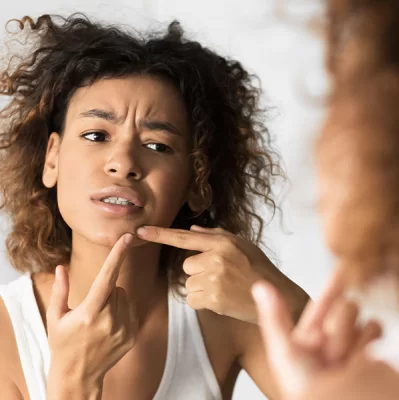Blackhead extraction
- What are blackheads and why do they form?
- Can you extract blackheads by yourself?
- What are the risks associated with squeezing blackheads?
- How to safely squeeze a blackhead, if necessary?
- What professional treatments help to remove blackheads?
- What active ingredients in cosmetics fight against blackheads?
- How to prevent the formation of new blackheads?
Blackheads, commonly known as comedones, are non-inflammatory skin changes. They occur when the openings of sebaceous glands (pores) become blocked by an excess of sebum and dead skin cells.
We distinguish open comedones, or blackheads, whose contents oxidize in contact with air, giving them a dark color. On the other hand, closed comedones, known as whiteheads, are located under the skin surface and do not have access to air.
The main cause of the formation of comedones is the overproduction of sebum, often genetically or hormonally determined. External factors (environmental pollution or stress) and improper keratinization of the skin also contribute to their formation. These imperfections most commonly appear in the T-zone (forehead, nose, chin), especially in individuals with oily or combination skin. It is important not to confuse them with sebaceous filaments, which are a natural element of healthy skin.
Skincare experts, including dermatologists and beauticians, strongly discourage removing blackheads independently. Improper procedures can seriously damage the skin and lead to inflammation, infections, and even the formation of permanent scars.
Professional skin cleansing requires sterility and precision. It is difficult to meet these conditions at home, making attempts to remove blackheads on your own not only risky but often also only yield short-term results.
Squeezing skin imperfections is associated with a serious risk of bacterial infection. By manipulating the lesions with dirty hands, bacteria like Propionibacterium acnes can be introduced deep into the skin. This can result in:
- inflammation and swelling,
- painful abscesses,
- permanent scars,
- difficult-to-remove discoloration,
- micro-wounds that become gateways for further infections.
Squeezing lesions in the so-called triangle of death, around the nose and mouth, is particularly dangerous because an infection from this area can spread all the way to the brain. It is also important to note that in some individuals, neuropathic acne may develop, characterized by a compulsive need to squeeze skin lesions.
It is not recommended to squeeze blackheads by yourself. However, if you decide to do so, hygiene is essential. Wash your hands carefully and cleanse your skin. To make it easier to remove the imperfections, soften the skin and open the pores - a warm shower or steam bath will help with that.
Remove the blackhead with the utmost gentleness. Use the pads of your fingers wrapped in a sterile gauze - never use your nails. Alternatively, you can use a specialized tool, such as a blackhead remover spoon.
After the procedure, be sure to disinfect the cleansed area. Then, apply an antibacterial tonic or hydrolat - both products will help restore the skin's proper pH and soothe any irritation.
Forget about risky home methods of squeezing blackheads. Professional cosmetology clinics offer much safer and more effective solutions in the fight against comedones. Proven methods of their removal include:
- manual skin cleansing,
- cavitational peeling,
- diamond microdermabrasion,
- chemical peels, using exfoliating acids, such as AHA acid,
- hydrogen cleansing,
- ultrasound,
- laser,
- comprehensive therapies (Acnelan or Aquapure).
When blackheads are very persistent, a visit to a dermatologist is recommended, who may prescribe appropriate medications. Remember, the key to success is proper skin care after the treatment.
To effectively combat blackheads, it is necessary to use well-chosen cosmetics with active ingredients. The most important substances fighting blackheads are:
- salicylic acid (BHA), which deeply cleanses pores,
- AHA acids, such as glycolic, almond, lactic, or citric acid,
- azelaic acid,
- pyruvic acid,
- retinoids, including retinol, which normalize skin function,
- niacinamide, regulating sebum secretion and acting anti-inflammatory.
It is also worth looking for ingredients that regulate sebum secretion, such as:
- clays, especially kaolin,
- activated charcoal,
- plant extracts, e.g. from green tea,
- fruit enzymes,
- antioxidants,
- benzoyl peroxide.
Always choose non-comedogenic cosmetics. These products do not clog pores, actively supporting skin cleansing, regeneration, and toning.
Effective combat against blackheads requires consistent, daily care for the skin. The key to healthy skin free of blackheads is comprehensive skincare routine, including:
- precise makeup removal,
- two-step skin cleansing (with oil and gel to remove impurities and unclog pores),
- regular exfoliation of dead skin cells (e.g. gentle enzymatic peeling),
- proper skin moisturizing, which helps regulate sebum secretion,
- using cleansing masks, e.g. based on clays,
- using non-comedogenic cosmetics that do not clog pores.

